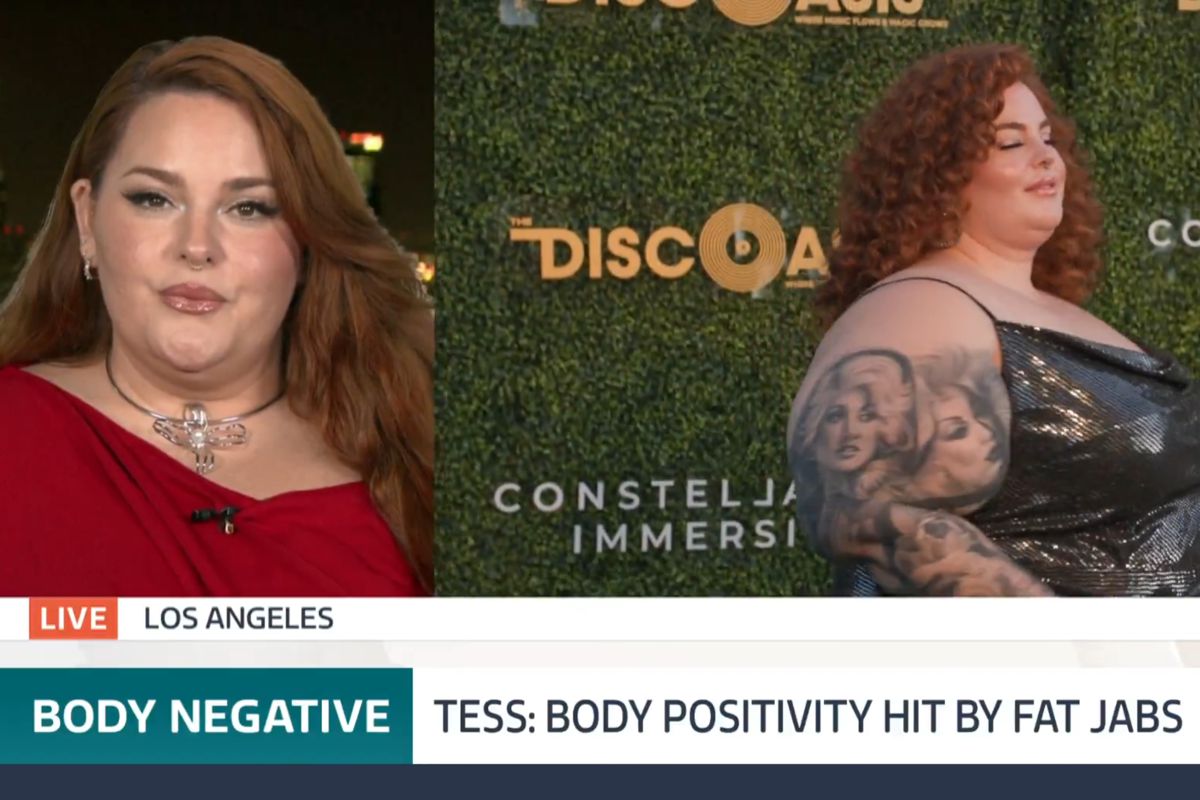
Fat Propaganda Roundup: Documenting the meatiest, juiciest cuts of “fat acceptance” propaganda from corporate and social media.
Celebrity heifer Tess Holliday and Co. no longer getting magazine spreads, Ozempic and fatphobia the scapegoats
For the last decade, plus-size* DEI diva Tess Holliday has milked the #bodypositivity golden calf for all it was worth, earning herself quasi-celebrity status and millions of dollars in the process.
(*“Plus-size” being a sweet euphemism serving to obscure reality, which is that, as long as we’re using superlatives, she might be better described as “triple-extra-plus-plus-sized.” By some estimates, Tess Holliday weighs in excess of 300 pounds. Even at the lower end of the estimation spectrum, she’s well over 250. We don’t know Holliday’s true gravitational pull for sure because society has yet to evolve to the point that we force these pastry-mongers onto scales in public coliseums in humiliation rituals — for their own good as well as the entertainment of the general public. In any event, my father’s satanic Mountain Dew-guzzling ex-wife from Jacksonville, whom I profiled in my groundbreaking memoir, Broken English Teacher: Notes From Exile, was much smaller than Holliday and clocked in at around 260.)
Related: ‘Body Positivity’ Activist Claims ‘Obesity’ Is a Fatphobic Slur
As she’s got a new book called “Take Up Space, Y’all,” a cheeky and upbeat reference to her morbid obesity, Holliday’s been on the media circuit pumping it up, as celebrities with astroturfed books they didn’t write themselves are wont to do.
Via Amazon (emphasis added):
“Take Up Space, Y’all gives teen readers a joyful, can’t-put-this-down reading experience with advice and colorful anecdotes from body positivity activist, top plus-size model, and inclusivity consultant, Tess Holliday. Tess Holliday has been on a mission to shift society’s mindset on what is beautiful, what is healthy, and what matters most of out life and living authentically. Now she and co-author, Kelly Coon, are combating the immense pressures society places on teens–from grades to social status to looks–and acknowledging these can have a negative impact on one’s physical and mental health.”
Here she is putting immense strain on an innocent TV set couch, hawking her wares to two sympathetic, reasonably normal-sized news actresses. (The one on the left in the blue dress is actually moderately clinically overweight, but by contemporary standards she appears thin because the Overton Window has shifted so far in favor of obesity.)
Despite her best efforts to maintain the glory days of glorified obesity, however, Holliday appears to be a member of a (literally) dying breed, at least as far as the fashion industry is concerned.
Via The Guardian (emphasis added):
“For all the strides the body positivity movement has made over the past decade, including within the fashion industry, there have been signs that the thin ideal was always going to make a comeback. You can blame the “wellness” culture that idealises thinness, or the return of 90s fashion, and the “heroin chic” bodies that wore it. Blame the rise of weight-loss injections such as off-label Ozempic, or the way fashion tends to swing back and forth. Or blame the demonisation of “wokeness” and diversity initiatives by conservatives. Or, blame it all, along with the fatphobia that never really went away, even though it pretended to. Models, activists and those of us who had hoped that fashion’s embrace of a range of sizes signified a genuine culture change are left wondering how it could have reversed so quickly. “I think you’re seeing the separation between people that were doing it because there was a movement at the time,” says Standley, “and the people who are truly passionate about it.”…
Felicity Hayward, a model and activist, thinks 2023 was a turning point. “Ozempic arrived into our industry, and there was a definite change,” she says. Hayward, who has modelled for Mac and appeared on the cover of i-D magazine, monitors the number of designers using curve models across the fashion weeks in London, Paris, New York and Milan for her report Inside the Curve. At first the drop was slow, but this season, she says, “we’ve started to see a huge decline. New York, which had 70 plus-size models in 2023, had 23 earlier this year. At the September 2024 London fashion week, 80 plus-size models were on the runway, but just 26 this year.””
Related: Autopsy: ‘Miracle’ Weight Loss Drug Kills Fat Nurse
On another jaunt pimping her book, this time on Good Morning Britain, Holliday blames the falling of her star, along with her obese colleagues’, on a “perfect storm” combination of GLP-1 agonist drugs (Ozempic, Wegovy, etc.), the collapse of DEI in general, and, of course, classic fatphobia — the bread that butters Holliday’s hustle. (No one is more enamored of fatphobia than Holliday; after all, if the evolutionarily wired, completely natural revulsion to morbid obesity ever truly disappeared, how would she sell her ghostwritten book?)
Related: ‘Critical Disability Studies’ Professor: Fatphobia ‘Undergirds’ Ozempic Craze
“I think that, collectively, our society has moved to a place where thinness is in, body positivity and curvy is no longer popular for a lot of brands, and that’s what we see reflected on runways and magazines… My plus-sized colleagues around the world, they’re not really working. So it’s been very disheartening to see… Ever since 2020, there’s been a rapid decline in diversity overall… it’s just kind of a perfect storm of, like, the jabs and where our culture is at right now.”
Plus-sized model Tess Holliday says she is no longer getting booked for runways, blaming weightloss jabs for undermining the body-positivity movement that made her so popular.
Tess, who did the catwalk for New York fashion week back in 2019, says she fears the unhealthy… pic.twitter.com/CiuUXqcR5v
— Good Morning Britain (@GMB) October 24, 2025











